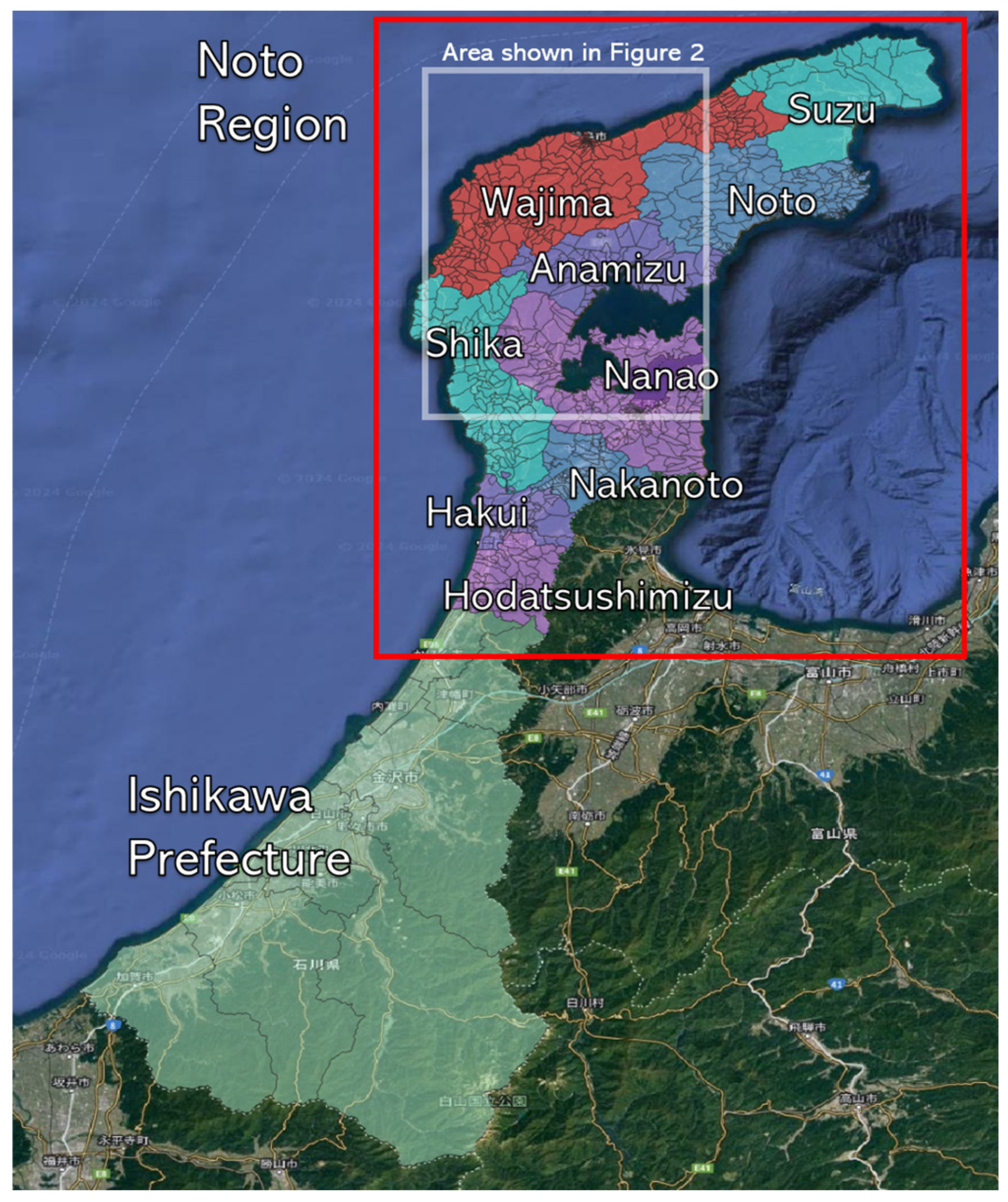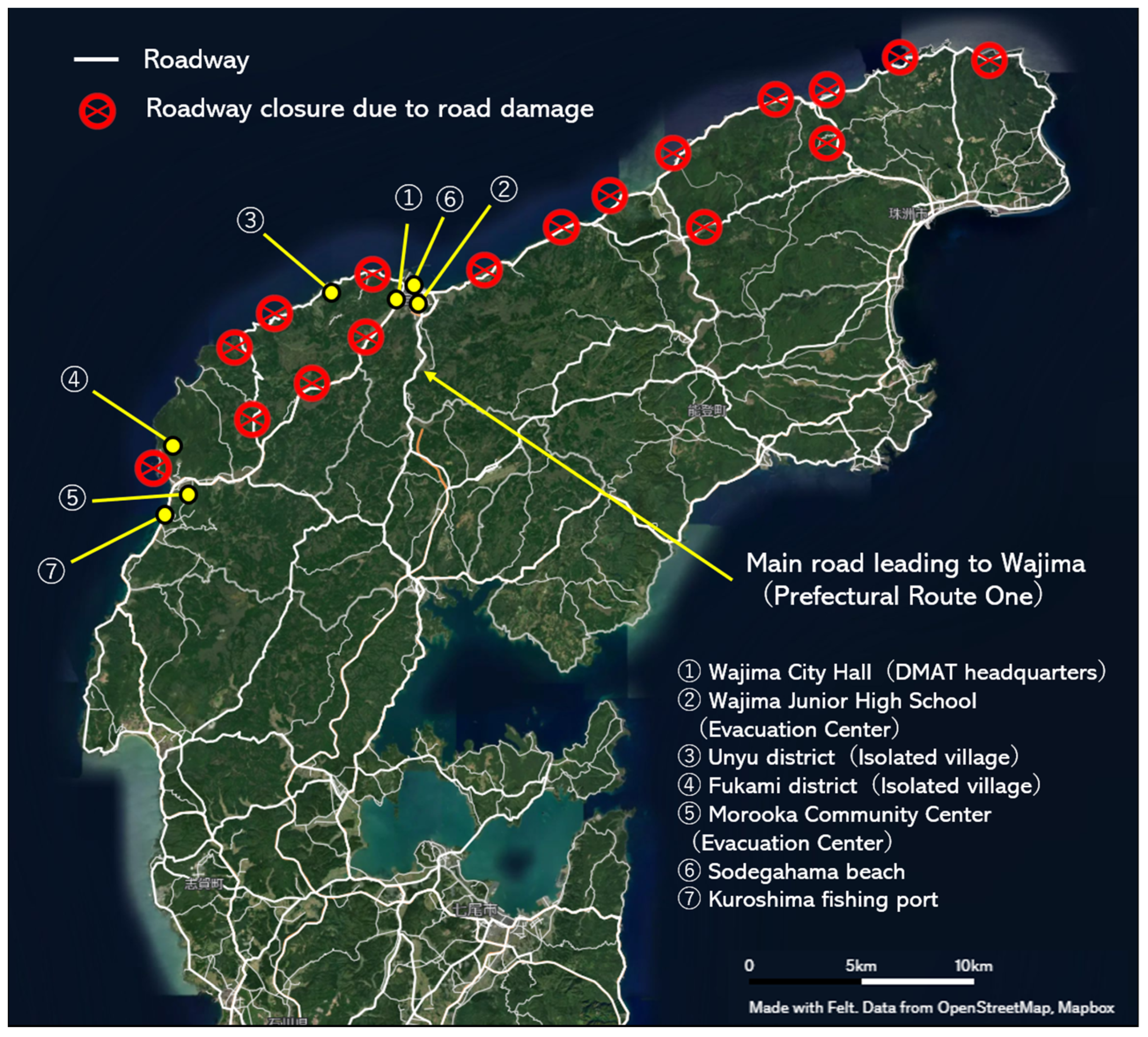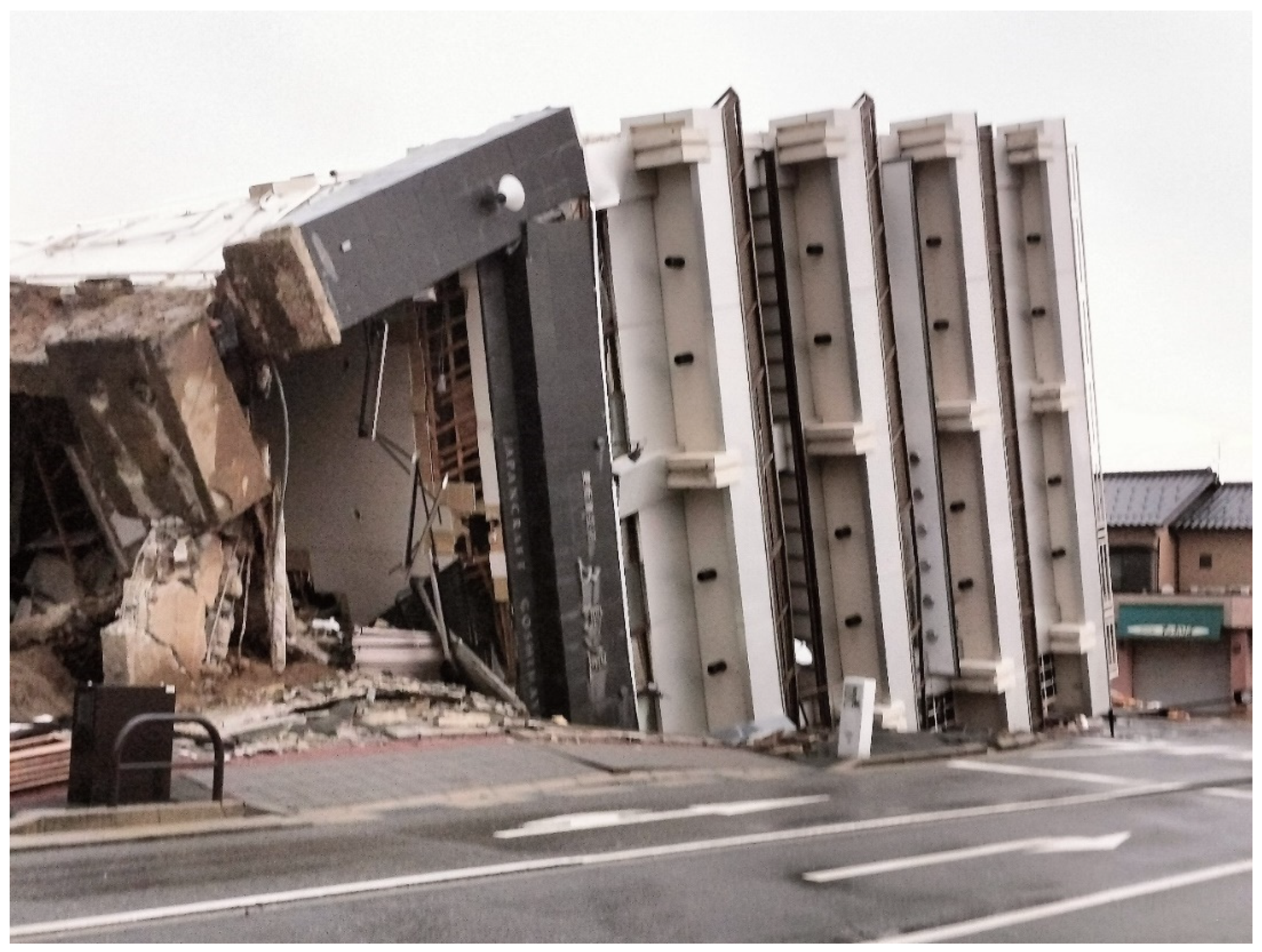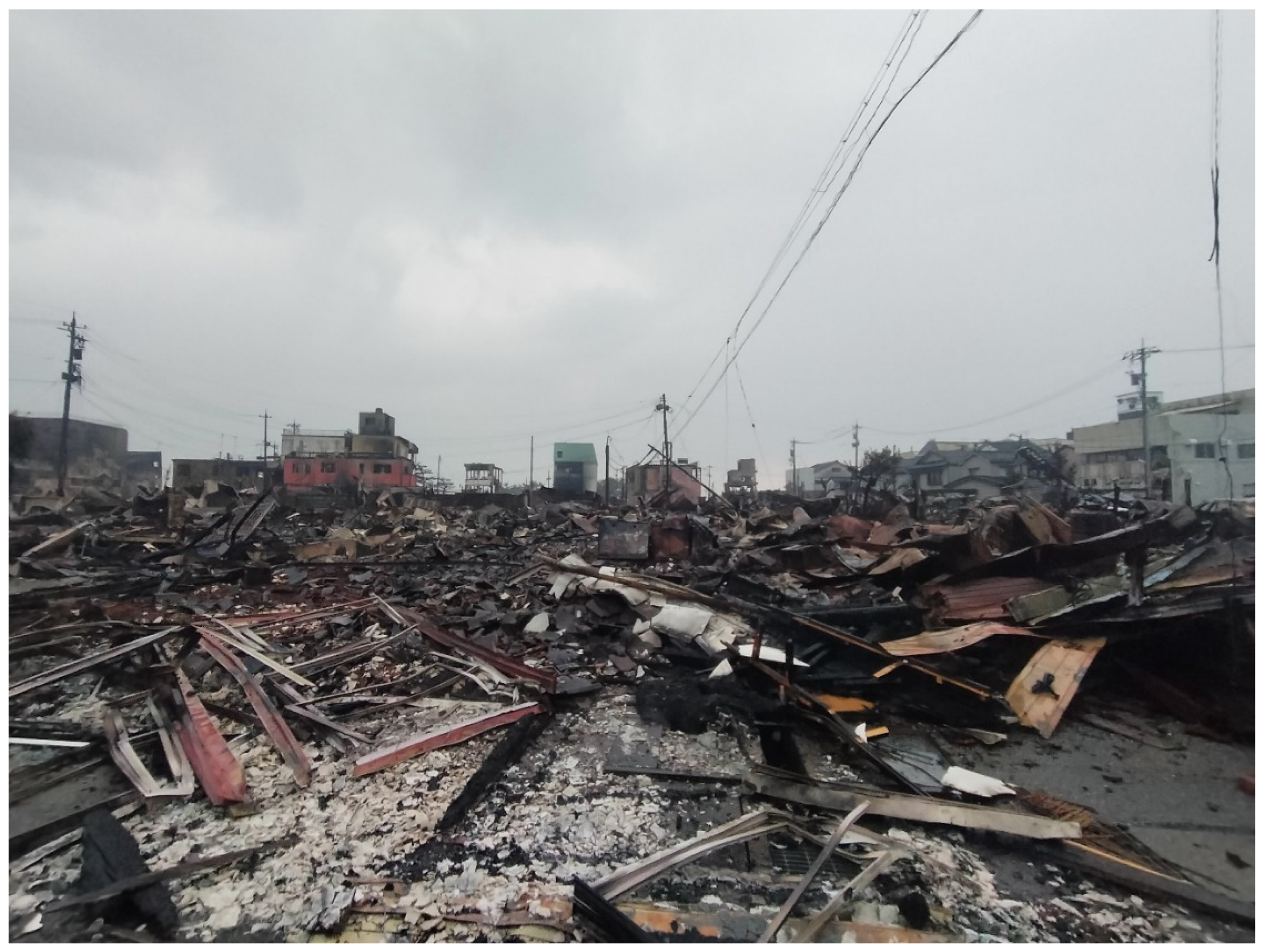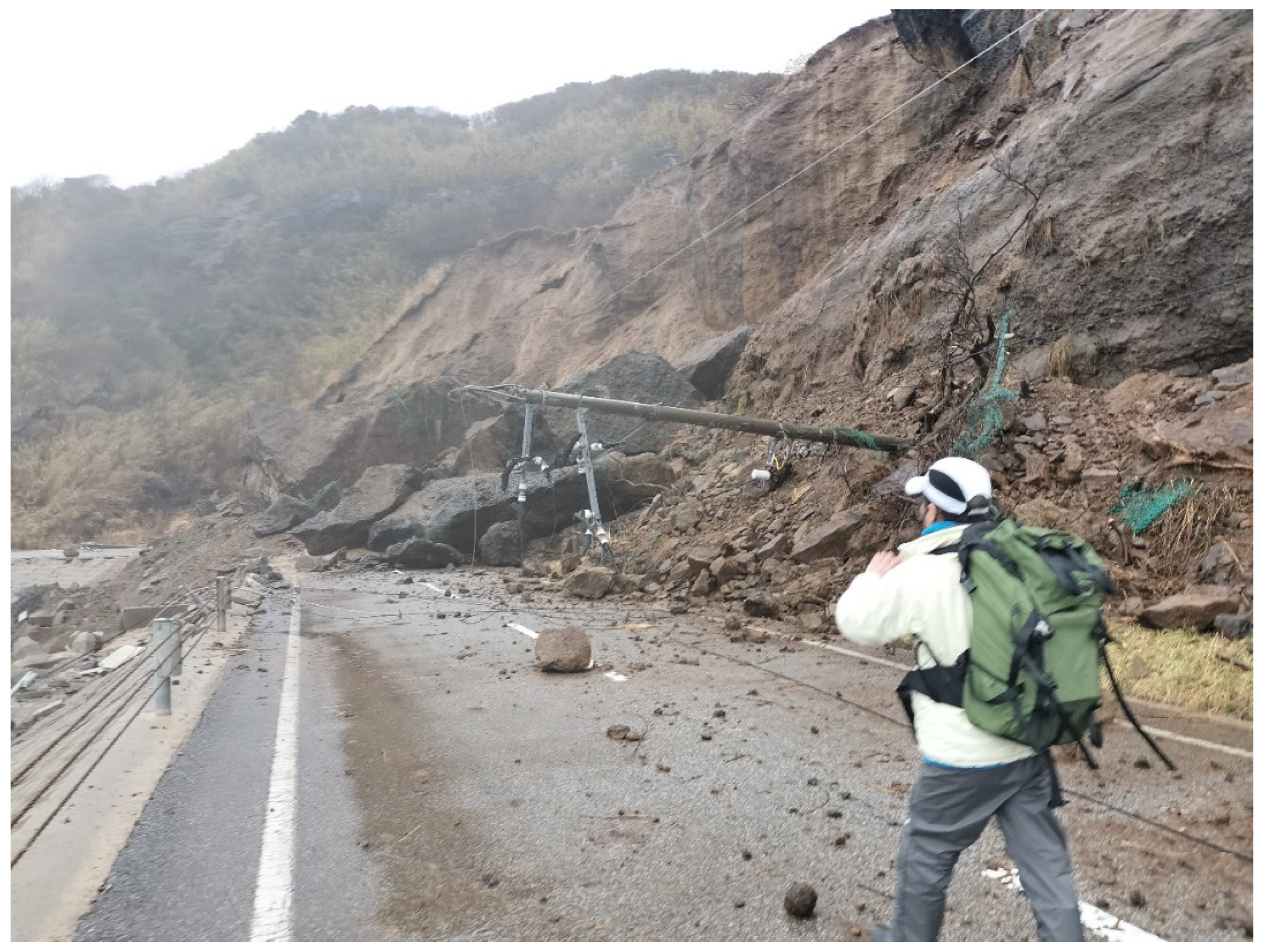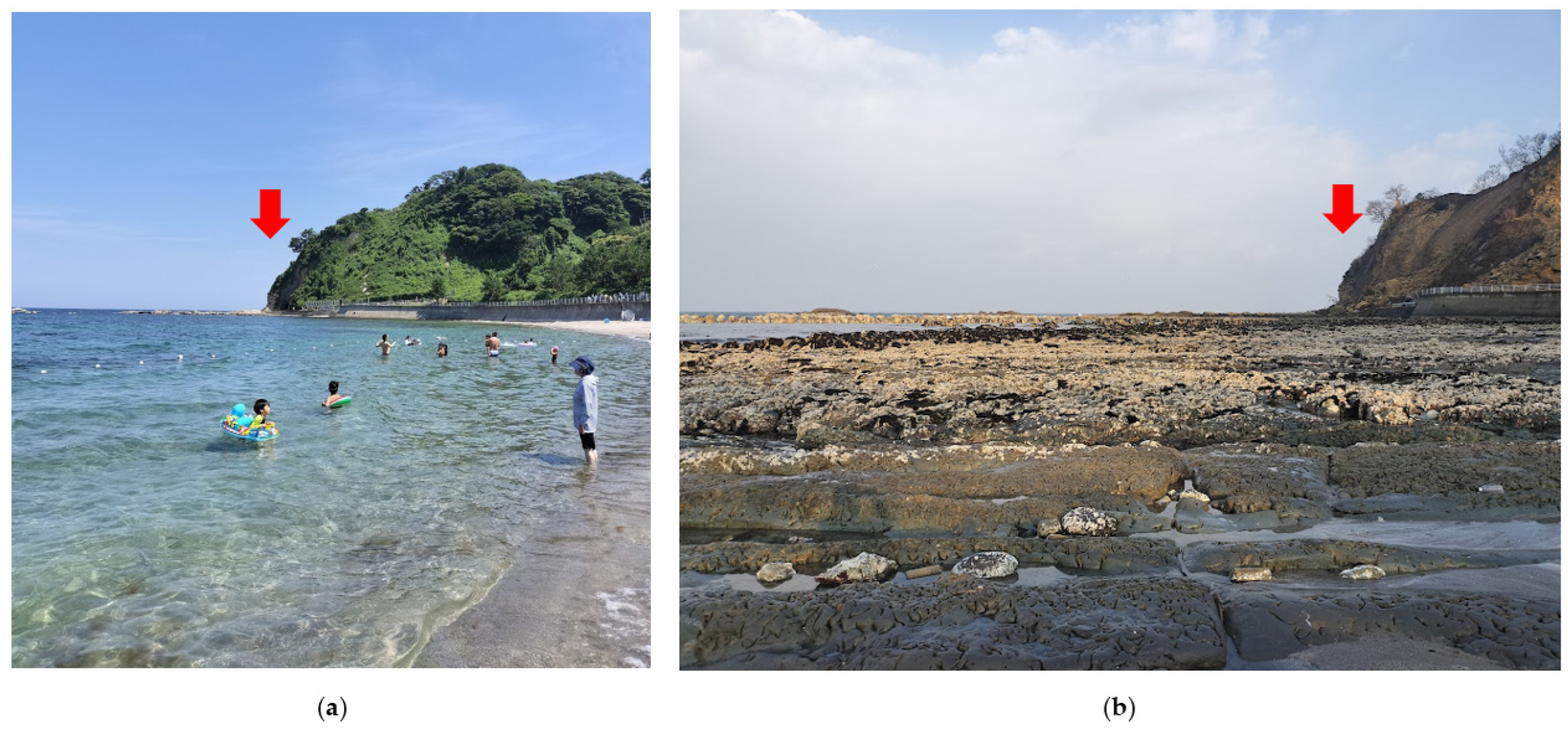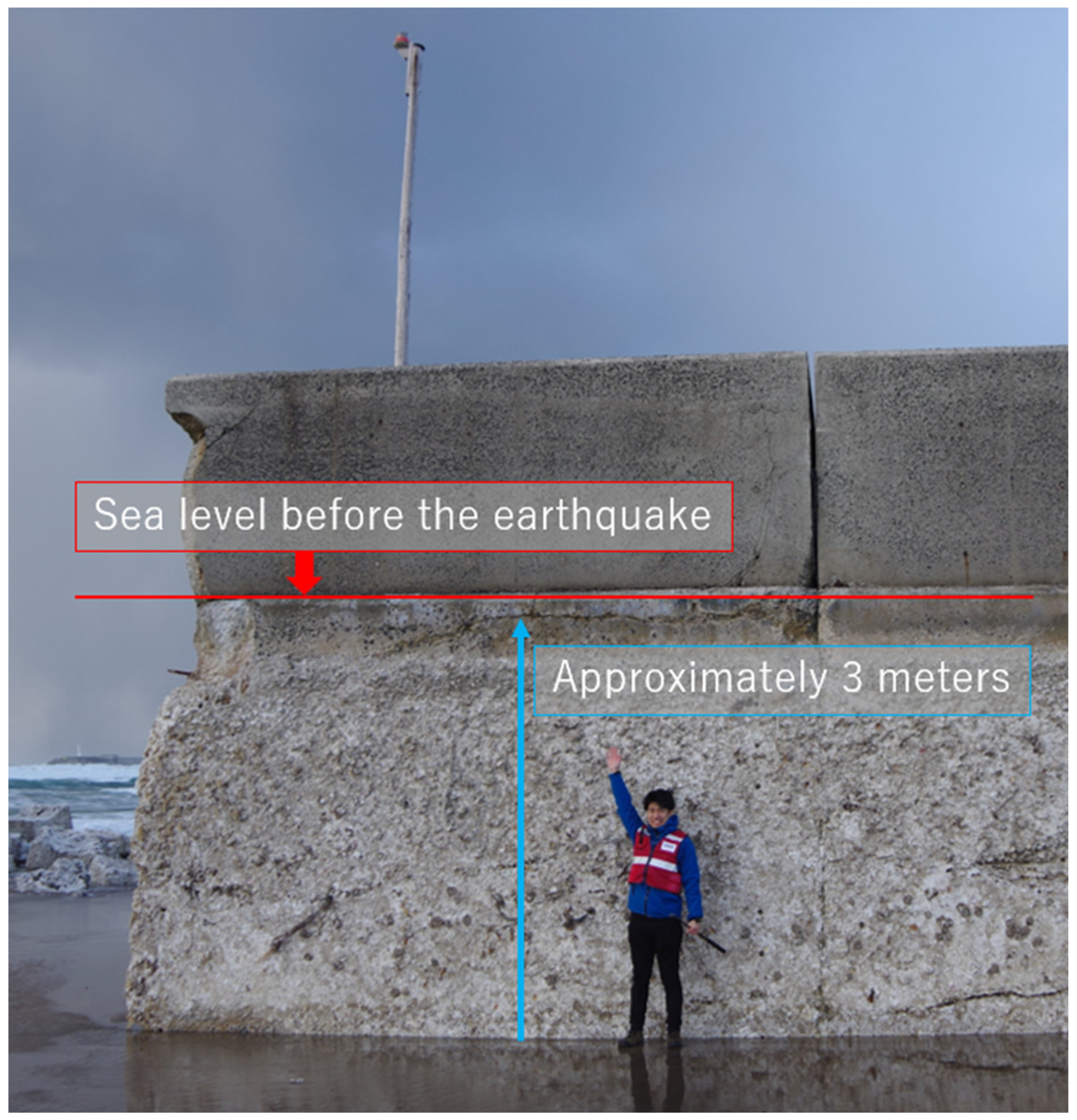1. Introduction
On January 1, 2024, at 16:10 (Japan Standard Time), an earthquake with a magnitude of 7.6 and a maximum Japan Meteorological Agency seismic intensity of 7 (Japan Meteorological Agency Seismic Intensity Scale) occurred in Japan, with its epicenter on the Noto Peninsula in Ishikawa Prefecture. Ishikawa Prefecture has a long topography that stretches from north to south, and the Noto region is in the northern part of the prefecture (
Figure 1). The epicenter depth was shallow at 16 km, and tremors were observed across almost all of Japan.
In the Noto region, which was the epicenter of the earthquake, many buildings collapsed because of violent shaking. According to an announcement from Ishikawa Prefecture, as of January 27, 43,369 damaged houses had been confirmed in Ishikawa Prefecture, and more than 30,000 of these were in the Noto region [
1]. The earthquake also triggered a tsunami that damaged at least 160 ha in Suzu City and Noto Town [
2]. The tsunami was estimated to be up to 4 m high, flooding fishing ports and buildings along the coast [
3]. A large-scale fire occurred in Kawai-machi, Wajima City, destroying 240 buildings including stores and homes. The area destroyed by the fire was 49,000 square meters. According to a report by the Ministry of Internal Affairs and Communications, it is speculated that the fire was caused by damage to indoor electrical wiring caused by the earthquake [
4]. Asaichi (morning market) Street in Kawai-machi, the center of the fire, is a famous tourist destination. Starting early in the morning, Wajima Asaichi is lined with stalls that sell seafood and vegetables. In addition, Asaichi Street was lined with many shops and factories selling Wajimanuri lacquerware, a traditional lacquerware craft. All of them were burned.
This earthquake caused water and sewage outages throughout the Noto region. It took time to restore the water supply, and even 10 days after the disaster, more than 100,000 households in Ishikawa Prefecture still had no water supply. Moreover, large-scale power outages also occurred. Immediately after the disaster, more than 30,000 households lost power. Because of the power outage, the Internet was unavailable, making communication difficult. It took time to restore the power outage, and as of January 11, more than 13,000 households were still without power.
More than 1,000 aftershocks, including earthquakes with a seismic intensity of 5 or higher, occurred within a week, forcing more than 20,000 residents of the Noto region to evacuate [
5]. This earthquake was one of the largest disasters in Japan in recent years. Nearly two weeks after the disaster, the full extent of the damage remained unclear, and the search for missing people continued. Progress up to 10 days after the disaster is summarized in
Table 1.
According to a damage summary released by the Fire and Disaster Management Agency in March, the earthquake affected 1,429 people, with 241 deaths and 1,188 injuries in Ishikawa Prefecture. There were 103 deaths in Suzu City, 102 in Wajima City, 20 in Anamizu Town, 8 in Noto Town, 5 in Nanao City, 2 in Shiga Town, and 1 in Hakui City [
6].
Immediately after the earthquake, the authors visited Wajima City, the disaster area, and conducted disaster relief activities. We patrolled Wajima City and checked the conditions of the roads and evacuation centers, and also conducted health observations of the evacuees at the evacuation centers. This paper discusses the characteristics of the disaster and proposes future issues related to disaster relief.
2. Materials and Methods
We visited disaster-affected areas immediately after the disaster, mainly in the city of Wajima, Japan. We gathered information on road conditions, evacuation center locations, and the number of people at the Disaster Medical Assistant Team (DMAT) headquarters set up at Wajima City Hall, and toured the affected areas. We visited many evacuation centers and isolated villages. We particularly focused on Wajima Junior High School, Unyu District, Fukami District, and Morooka Community Center (see
Figure 2). This earthquake caused many areas to be closed to vehicular traffic owing to slope collapse and road damage. Roads were cut off in many places, especially along the coastline; consequently, numerous villages were isolated from the outside. We approached the isolated villages on foot.
As we are both researchers and medical staff, we also provided direct support at evacuation centers, including transporting supplies, running soup kitchens, and providing information. The information we provided was important to evacuees, as communications networks were destroyed and there was no Internet access in most evacuation centers. We also worked as medical professionals, measuring the blood pressure and body temperature of the evacuees, assessing their physical condition, and providing necessary advice according to the physical condition of the evacuees. Infection control measures are important at evacuation centers. We advised evacuees on ventilation and how to maintain hygiene in toilets to prevent the spread of infectious diseases in evacuation centers. We asked the evacuees about their lives and the operations at the evacuation center. As we were particularly concerned about the evacuees’ physical condition, we asked about the support of medical staff, especially DMATs, who had been working in the disaster area since the day after the disaster. Furthermore, we asked whether sufficient food and other relief supplies had been delivered. While traveling through the disaster area, we observed damage to buildings and roads as well as changes in the topography.
This report integrates and discusses the results of the site visits, information broadcasts by public institutions, and previous research.
3. Results
The Noto area, where the Noto Peninsula earthquake occurred, includes three cities and five towns: Wajima City, Suzu City, Hakui City, Noto Town, Nakanoto Town, Anamizu Town, Shiga Town, and Hodatsushimizu Town (
Figure 1). On January 5th, four days after the earthquake, we visited Wajima City, which was hit hard. The expressway was closed as it entered the Noto area, so we drove along the prefectural roads.
Prefectural roads were undulated and damaged in several places. Many utility poles had fallen, and buildings were damaged everywhere. Prefectural Route 1, which connects to Noto, had experienced landslides in several places, narrowing the width of the road usable for vehicle traffic. Prefectural Route 1 had alternating traffic, making it prone to traffic jams. The east-west coastal road leading to Wajima was closed because of landslides and road collapses (
Figure 2).
We entered Wajima City and observed that the city had been destroyed. A large building had collapsed (
Figure 3) and a wide area of Kawai-machi was destroyed by fire (
Figure 4). We stayed there for a week and toured the evacuation center. The evacuation center was without water. They cooked with water brought in by the Self-Defense Forces. As water cannot be flushed down toilets, human excreta was solidified with a coagulant before disposal. The evacuation center was managed by evacuees. The evacuation center leader, who was also an evacuee, took command, and the evacuees worked together to sort and cook the relief supplies. Noto’s population is aging. Many people who gathered at the evacuation centers were older adults. At the evacuation center, the amount of exercise among the evacuees decreased. The sanitary environment at the evacuation center could not be considered adequate, and some evacuees became ill. However, there were no regular rounds for medical professionals. Infectious diseases were prevalent in many evacuation centers. Influenza and new coronavirus infections were particularly common. In Japan, when a large-scale disaster occurs, a DMAT, which is a trained medical team with the mobility to act during the acute phase of a disaster, is activated [
7]. The DMAT also implements measures to control infectious diseases. However, due to the widespread damage caused by this earthquake, infection control measures had been delayed.
Many evacuation centers in Wajima City were isolated because roads were cut off. We visited an isolated evacuation center on foot on January 10
th (see
Figure 5). Village residents had gathered at the evacuation center, most of them older adults. The power outage continued, and communications such as mobile phones and the Internet were unavailable. The evacuees at the isolated evacuation center did not know exactly what the conditions were in the Noto area. The Self-Defense Forces transported the supplies needed at the isolated evacuation centers. The evacuees said that there was no intervention by medical professionals.
Additionally, rises in the sea floor has been observed on the north coast of the Noto Peninsula [
8]. This has resulted in the unavailability of many ports. The port of the isolated area we visited had also become unusable because of upheaval. Perhaps for this reason, Self-Defense Force ships were anchored slightly offshore, and Self-Defense Force members transported supplies in rubber boats. We observed seafloor uplift at Sodegahama Beach and the Kuroshima Fishing Port in Wajima City (
Figure 6 and
Figure 7).
4. Discussion
4.1. Characteristics of This Disaster
In this earthquake, the recovery of infrastructure and the response to evacuees tended to be slower than in previous earthquakes. During the 2011 Great East Japan Earthquake, there was a large-scale power outage in the Tohoku Electric Power Company, yet three days after the disaster, power had been restored to approximately 80% of the area, except for Miyagi Prefecture [
9]. Conversely, restoration work for the power outage caused by this earthquake was continuing in most areas even 10 days after the disaster, and there was no hope of complete restoration. Temporary toilets were available at evacuation centers three days after the Great East Japan Earthquake. However, even after one week, the installation of temporary toilets at the evacuation center was incomplete.
The delay in restoration is due to the geographical characteristics of Ishikawa Prefecture. When the Great East Japan Earthquake occurred in 2011, rapid recovery efforts were undertaken by sending support units into the affected area in a comb-like pattern from the north-south road [
10]. Ishikawa Prefecture has a long and narrow topography running north to south, and only a few major roads connect the northern and southern parts of the Noto area. This earthquake not only caused major damage to the main roads but also heavy traffic congestion. In addition, roads from the east and west coasts of Wajima were closed because of widespread landslides. Consequently, disaster relief and construction vehicles for infrastructure restoration were unable to enter the area, causing recovery delays. In addition, most of Noto is mountainous. This earthquake isolated many villages owing to large-scale landslides over wide areas. Not only was it difficult to transport supplies to isolated villages, but communication was also cut off because of power outages, which made it difficult to gather information. Furthermore, the incredible phenomenon of seafloor upheaval prevented ships from approaching areas where roads had been cut off, potentially delaying recovery.
4.2. The Importance of Autonomous Disaster Relief
The damage caused by this disaster was so extensive that it was difficult for the DMATs or local governments to understand the entire situation. Presumably, the delay in infection control measures and lack of intervention by medical professionals in evacuation centers in remote areas were due to the DMATs being forced to invest manpower in rescue operations. In this situation, we believe that team activities that support DMATs are important. It is important to have a team that can determine and carry out the necessary activities on site even without instructions from the DMAT. After receiving general information from the DMAT, they go to the site and perform activities based on their own judgment and then share the results with the DMAT. We believe that if such activities are implemented, the burden on DMATs will be reduced and detailed support will be provided at evacuation centers.
The same applies to nonmedical support. Immediately after the disaster, DMATs provided medical support; simultaneously, Wajima City, a local government, was responsible for managing the transportation of food and relief supplies. However, the disaster was at a large scale and there were numerous evacuation centers, making management extremely difficult. Some volunteers worked effectively in transporting supplies to the evacuation centers. The teams collaborated in Wajima. However, rather than waiting for instructions from Wajima City, they made their own decisions and took action based on the situation. The results were fed back to Wajima City. These volunteer teams were not the only ones effective in assisting evacuees. Immediately after the disaster, some stores opened and sold supplies. Victims were not necessarily located in the evacuation centers; some people were living as evacuees in homes that had survived the collapse. The fact that the stores remained open under difficult circumstances immediately after the disaster must have greatly helped residents of the disaster area. Ishiwatari et al. highlighted the importance of the role of the private sector, stating that in large-scale disasters, the private sector is important in transporting supplies and selling food and medicine [
11]. These points apply to the Noto Peninsula earthquake.
In addition, we think it would be effective for DMATs and local governments to plan with support teams about what to do in case of an emergency before a disaster occurs so that disaster support can be implemented autonomously without detailed instructions after a disaster occurs. Indeed, it is not possible to anticipate and prepare for every disaster situation. However, by discussing who will take what actions immediately after a disaster, it should lead to swift action immediately after one occurs. Particularly during large-scale disasters like this one, where communication is cut off, it would be a good idea for those involved in discussions to assume that communication will be impossible immediately after the disaster occurs. This is not limited to disasters in Japan. The framework released by the United Nations also emphasizes the role of volunteers and the private sector in making recommendations on disaster losses [
12].
4.3. The Importance of Autonomy for Evacuation Centers
Araki et al. highlighted that in large-scale disasters, people may evacuate to places other than designated evacuation centers, and there may be a discrepancy between predetermined plans and the actual situation [
13]. For example, in the 2007 Chuetsu Earthquake, 42 voluntary evacuation centers were established in addition to the pre-planned evacuation centers [
14]. Local governments needed 12 days to track down all evacuation centers. Many voluntary evacuation centers were established during the Noto Peninsula earthquake. It took time for the DMAT headquarters to determine where the voluntary evacuation centers were set up. At voluntary evacuation centers, supplies were transported by the Self-Defense Forces, but the centers were not operated by DMATs or professionals. The Self-Defense Forces’ mission is to transport supplies, and they are basically not involved in the operation of evacuation centers. Naturally, the evacuees themselves had to run the evacuation center.
In the wake of the Great East Japan Earthquake, one study compared evacuation centers with professional public health nurses on duty and evacuation centers without them. According to Mori et al., having a public health nurse permanently present is advantageous in building relationships with evacuees [
15]. It is believed that having a public health nurse permanently stationed at a facility was advantageous in managing the health of evacuees and making use of their expertise. Contrariwise, Mori et al. highlighted that having them stationed full-time increases the burden on public health nurses. During the Noto Peninsula Earthquake, many villages were isolated and voluntary evacuation centers were created because of broken roads. Therefore, it was practically impossible to station public health nurses and other professionals full-time at these locations, and even if it were possible, the burden on the professionals would have been heavy. Operating evacuation centers based on evacuees’ autonomy will reduce the burden on professionals. In the self-governed evacuation centers and isolated villages visited by the authors, decisions were made regarding the evacuees’ living spaces, food management, hygiene management, and evacuation rules. Evacuation center management was not sufficient. However, compared to the evacuation centers frequently visited by the DMAT in central Wajima City, the management was no worse. Why were evacuation centers so well managed despite the absence of professionals? Recently, Japan has experienced several disasters. Each time, information is shared with the public through the media. This is thought to have affected the independent management of evacuation centers. In addition, the authors occasionally heard from the evacuees that local residents had become closer to each other. It is believed that cohesion among residents was strengthened by cooperating with each other in operating the evacuation center. Discussions among residents are a prerequisite for independent evacuation center management. Therefore, daily communication among the residents is important. Thus, forming healthy communities on a daily basis is one form of disaster prevention. However, there is one negative point. Mori et al. also highlighted that in evacuation centers where public health nurses are not permanently stationed, evacuees become more cohesive and exclusive. In fact, in the 2024 Noto Peninsula Earthquake, there were cases where local government officials urged residents of isolated villages to evacuate to prevent secondary disasters, but they were slow to listen.
In summary, the autonomy of evacuation centers has the effect of responding to unplanned situations and reducing the burden on local governments, DMATs, and professionals. Compared to regular evacuation centers, voluntary evacuation centers strengthen the bonds among evacuees.
5. Conclusions
This earthquake was characterized by transportation being blocked due to geographical factors, which made infrastructure restoration and support activities difficult. Under such circumstances, it is important for disaster victims to manage their own evacuation centers. In addition, support teams that can operate independently are required in evacuation centers in remote areas, where the support of DMATs cannot reach sufficient levels. To prepare for a disaster, administrative agencies and support teams need to plan in advance what they will do in the event of a disaster. It is believed to be effective to decide in advance how volunteer teams and the private sector will carry out their activities, assuming that they will be unable to contact public institutions during a disaster. In large-scale disasters, evacuees must operate evacuation centers autonomously. To achieve this, it is necessary for residents to form healthy communities regularly.
Given the extensive damage caused by this disaster, recovery will take time.. In the future, we will need to monitor the development of infrastructure, the health of evacuees, and the recovery of the town, and provide appropriate support. A serious disaster may soon occur in Japan. We hope that the experience of this disaster will be useful in preparing for future disasters.
Acknowledgments
We would like to express our gratitude to Editage (
www.editage.jp) for their pro bono English editing support for the Noto Peninsula Earthquake.
Conflicts of Interest
The authors declare no conflicts of interest.
References
- Ishikawa prefecture Regarding the Status of Damage Caused by the 2024 Noto Peninsula Earthquake (in Japanese). Available online: https://www.pref.ishikawa.lg.jp/saigai/documents/higaihou_69_0127_1400.pdf (accessed on 18 March 2024).
- JAPANESE RED CROSS SOCIETY Operation Update, No.30: 2024 Noto Peninsula Earthquake: The Japanese Red Cross Society’s Response. Available online: https://www.jrc.or.jp/english/relief/2024NotoPeninsulaEarthquake.html (accessed on 18 March 2024).
- Earthquake Research Promotion Headquarters Earthquake Research Committee Evaluation of the 2024 Noto Peninsula Earthquake. Available online: https://www.static.jishin.go.jp/resource/monthly/2024/20240101_noto_2.pdf (accessed on 18 March 2024).
- Ministry of Internal Affairs and Communications Investigation of the Large-Scale Fire in Wajima City That Occurred during the 2024 Noto Peninsula Earthquake (in Japanese). Available online: https://nrifd.fdma.go.jp/research/saigai_chousa_shien/notohantou_jishin/files/20240215_1.pdf (accessed on 18 March 2024).
- Cabinet Office Regarding the Damage Caused by the 2024 Noto Peninsula Earthquake (in Japanese). Available online: https://www.bousai.go.jp/updates/r60101notojishin/r60101notojishin/index.html (accessed on 18 March 2024).
- Fire and Disaster Management Agency Disaster Control Headquarters Damage Caused by the 2024 Noto Peninsula Earthquake and Response Status of Fire Departments (in Japanese). Available online: https://www.fdma.go.jp/disaster/info/items/20240101notohanntoujishinn84.pdf (accessed on 18 March 2024).
- Wato, Y. Japanese DMAT (Disaster Medical Assistance Team) and the Future National Disaster Medical System (in Japanese). The Journal of Japan Society for Clinical Anesthesia 2014, 34, 692–698. [Google Scholar] [CrossRef]
- Geospatial Information Authority of Japan Coastline Change Caused by the 2024 Noto Peninsula Earthquake Detected by ALOS-2 SAR Satellite Image (Jan. 4, 2024). Available online: https://www.gsi.go.jp/uchusokuchi/uchusokuchi-e31001.html (accessed on 18 March 2024).
- Chen, X.; Numada, M.; Meguro, K. The Priority of Electric Power Restoration in the East Japan Earthquake (in Japanese). Available online: http://library.jsce.or.jp/jsce/open/00578/2012/4-323.pdf (accessed on 18 March 2024).
- Earthquake Memorial Museum Kushinoha-Sakusen (Operation Comb Teeth) (in Japanese). Available online: https://infra-archive311.thr.mlit.go.jp/s-kushinoha.html (accessed on 18 March 2024).
- Ishiwatari, M. Institutional Coordination of Disaster Management: Engaging National and Local Governments in Japan. Nat Hazards Rev 2021, 22. [Google Scholar] [CrossRef]
- United Nations Disaster Preparedness for Effective Response -Guidance and Indicator Package for Implementing Priority Five of the Hyogo Framework- Hyogo Framework for Action 2005-2015: Building the Resilience of Nations and Communities to Disasters. Available online: https://interagencystandingcommittee.org/sites/default/files/migrated/2014-10/Disaster-preparedness-for-effective-response-web.pdf (accessed on 15 March 2024).
- ARAKI, Y.; TSUBOI, S.; HOKUGO, A. Patterns of Emergency Shelters in Coastal Plains a Case Study after the Great East Japan Earthquake and Tsunami in Higashi-Matsushima City. JAPAN ARCHITECTURAL REVIEW 2020, 552, 3–4. [Google Scholar] [CrossRef]
- Kato, K. Research on Information Gathering Processes during Natural Disasters: The Case of the Kashiwazaki City Office in the Niigata Chuetsu-Oki Earthquake (in Japanese). Study on the Role of Existing Residents Self-Governance Association in Disaster Time A Case Study of Residents Welfare Council in Saka Town 2008, 8, 73–85. [Google Scholar]
- Mori, H.; Obuchi, S.P.; Sugawara, Y.; Nakayama, T.; Takahashi, R. Comparison of Two Evacuation Shelter Operating Policies and the Role of Public Health Nurses after the Great East Japan Earthquake: A Qualitative Study. Int J Environ Res Public Health 2020, 17, 8310. [Google Scholar] [CrossRef] [PubMed]
|
Disclaimer/Publisher’s Note: The statements, opinions and data contained in all publications are solely those of the individual author(s) and contributor(s) and not of MDPI and/or the editor(s). MDPI and/or the editor(s) disclaim responsibility for any injury to people or property resulting from any ideas, methods, instructions or products referred to in the content. |
© 2024 by the authors. Licensee MDPI, Basel, Switzerland. This article is an open access article distributed under the terms and conditions of the Creative Commons Attribution (CC BY) license (https://creativecommons.org/licenses/by/4.0/).
